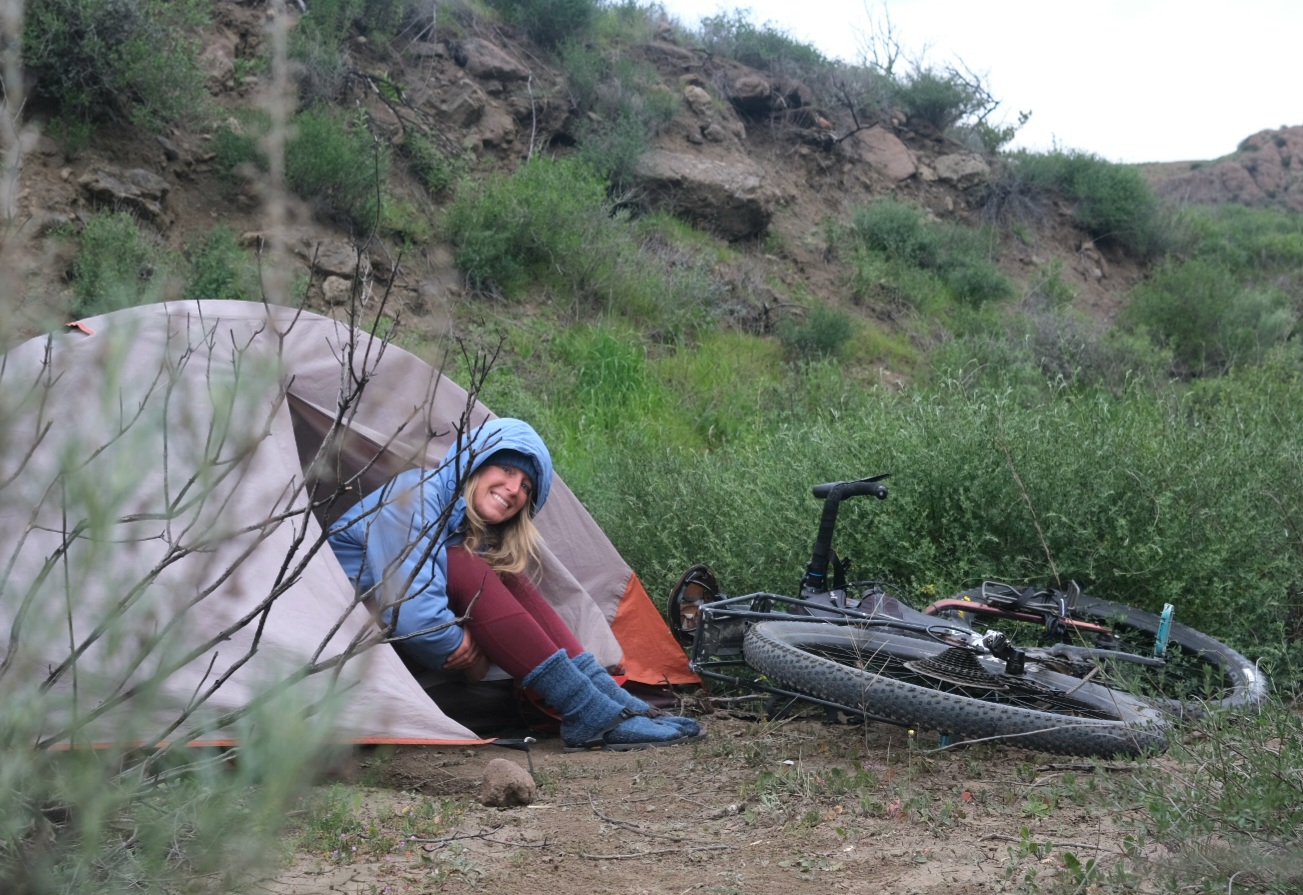
By Ambassador Laura Killingbeck
I love camping year-round; I also love staying warm! This winter, I rode the Adventure Cycling Association’s Pacific Coast Route from San Francisco to southern California. Temperatures hovered in the 40’s and 50’s during the day, and fell into the 30’s and 40’s at night. It wasn’t as cold as the northern US at that time, but it was cool enough that I needed to actively consider how to stay warm. I also needed to be ready for California’s sudden weather fluctuations which included rain storms, high winds, snow, and hail!
As I rode and camped, I often thought about the gear I had and felt very grateful for the items that kept me warm. The following are five items that I especially loved.
An Insulated Thermos
I could talk all day about my Montbell Alpine Thermos. It’s basically a miracle in the form of a bottle. I learned about this thermos after reading the book “Thirst” by endurance hiker Heather Anderson. In 2013, Heather broke the speed record for hiking the Pacific Crest Trail unsupported. It was an amazing feat and her book had me riveted.
I went to Heather’s website, poked around her gear lists, and was surprised to see this thermos on there. Since when do ultra-light endurance athletes carry anything as gratuitous as a metal thermos?? I was so intrigued that I ordered one, and it’s been part of my permanent backcountry kit ever since.
Every night when I’m camping, I add 3-4 teaspoons of coffee grounds to my thermos and fill it up with boiling water. Then I cap it and toss it in my sleeping bag. In the morning I wake up, reach down for my thermos, and pour myself a cup of steaming coffee–without even unzipping my sleeping bag. It is divine.
The genius of the Montbell Thermos is that it has two caps, an inner and an outer. The outer cap doubles as a coffee mug. The inner cap is threaded and screws in and out to allow different amounts of liquid out when you pour. If you unscrew the inner lid just slightly, it acts as a coffee filter, allowing the hot liquid to pour out of the thermos, but the coffee grounds to stay inside. The thermos is so well insulated that my coffee is always steaming in the morning.
One note–this thermos is so well insulated that when you store it in your sleeping bag, it doesn’t actually keep the bag warmer. The thermos retains almost all its heat, which is why my coffee is always still hot in the morning. An easy way to actually heat up your sleeping bag is to fill a regular water bottle with hot water, cap it tightly, and toss it in the sleeping bag. This will slowly let off heat and keep you toasty while you sleep.

Sacred Socks
When I was 23, I got rid of all my stuff, booked a one-way ticket to Alaska, and started biking south. Along the way, I enrolled in a ten-day Wilderness First Responder Course. One of my instructors was a climber who worked for Search and Rescue, and she had us on the edge of our seats with her stories about rescuing people who were on the verge of freezing to death. Of all the advice she gave us about staying warm in cold weather, one thing stuck with me forever: always carry sacred socks!! Sacred socks are your warmest, fluffiest, coziest socks. You store them in your sleeping bag, so when you go to bed at night you always have a way to keep your feet warm.
Since then, I’ve always carried sacred socks. My current pair are fluffy alpaca socks that a friend gave me. They warm my toes and also my spirit. Sometimes having one super soft, fluffy item is enough to make you feel warm all over.
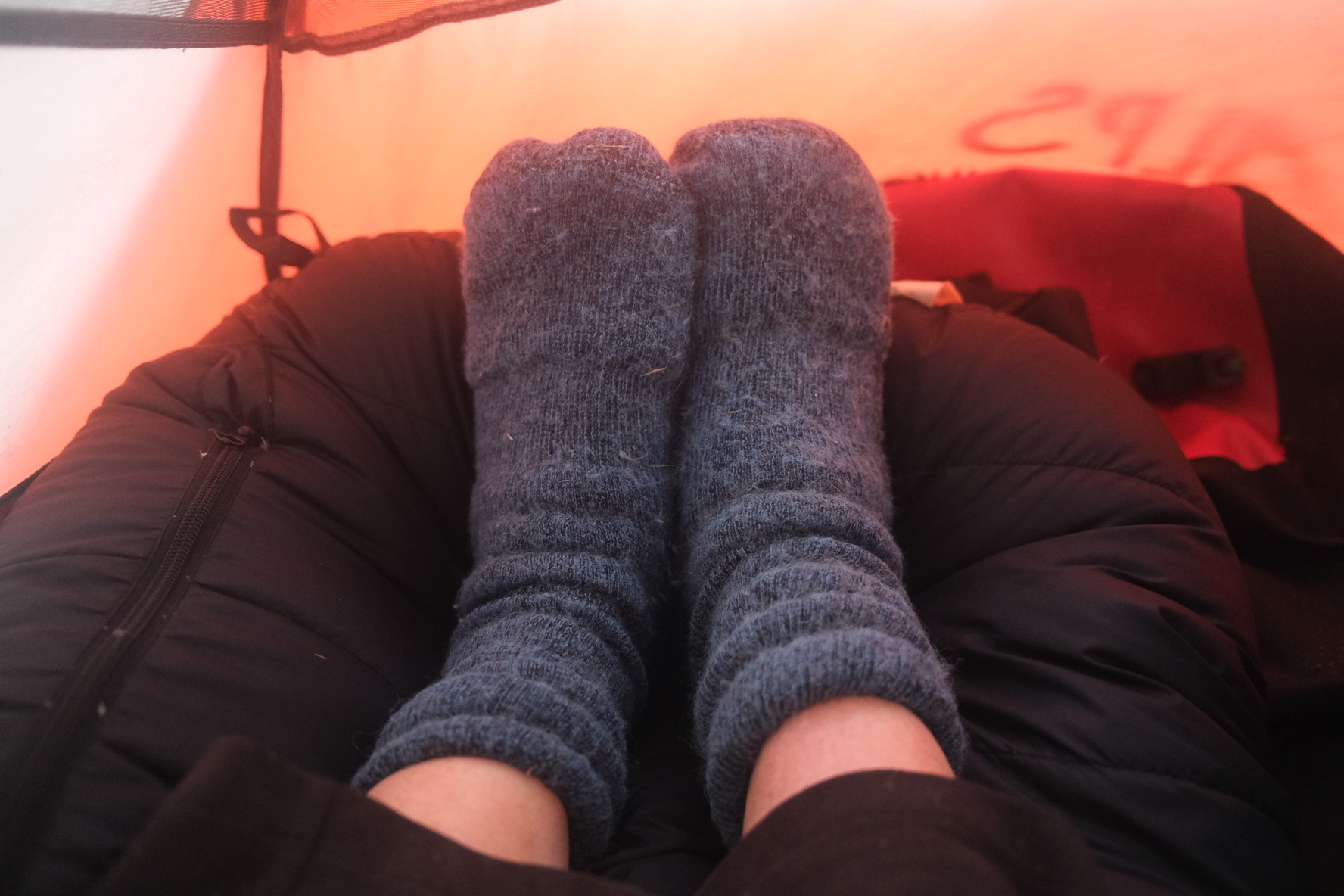
A Pee Style
Where would I be without my pee style!? Probably lost in a forest somewhere, still trying to find a discreet place to pee.
The pee style is a small, light, half-funnel that allows you to pee while standing up. For women, trans, and nonbinary folks this is a game-changer because it means you don’t have to pull your pants down to pee. So in cold weather, your butt stays much warmer!
The pee style also frees me up to pee closer to the road, or even off the side of my bike (while standing, not riding!). This gives me the comfort of drinking as much water as I want without worrying about where to stop to use a bathroom. Good hydration helps the body regulate heat more effectively, so it’s a total win.

Layers: Inner and Outer
Before I started this trip, I sat down and considered which gear items I needed to replace. I decided that if I was going to upgrade any of my layers, it should be my innermost layer (my baselayer) and my outermost layer (my raingear). These two layers are crucial for balancing and protecting body heat by mediating wetness from rain or sweat.
On my last long trip through-hiking the Florida Trail, I accidentally shredded my merino baselayer shirt on a tree branch, and my rain jacket molded so badly I had to throw it out. (I had no idea rain jackets could mold like that, it was fascinating!) So I really was due for an upgrade.
I decided to research a few companies and reach out to my favorites to see if I could test some product samples. I’m generally very wary of product samples, because you never know what kind of quality they’ll be, and on a long journey you can’t afford to cart around anything that isn’t truly valuable and relevant. But in this case, two of the sample sets I received stood out as all-stars: VOORMI baselayers and Showers Pass rain gear.
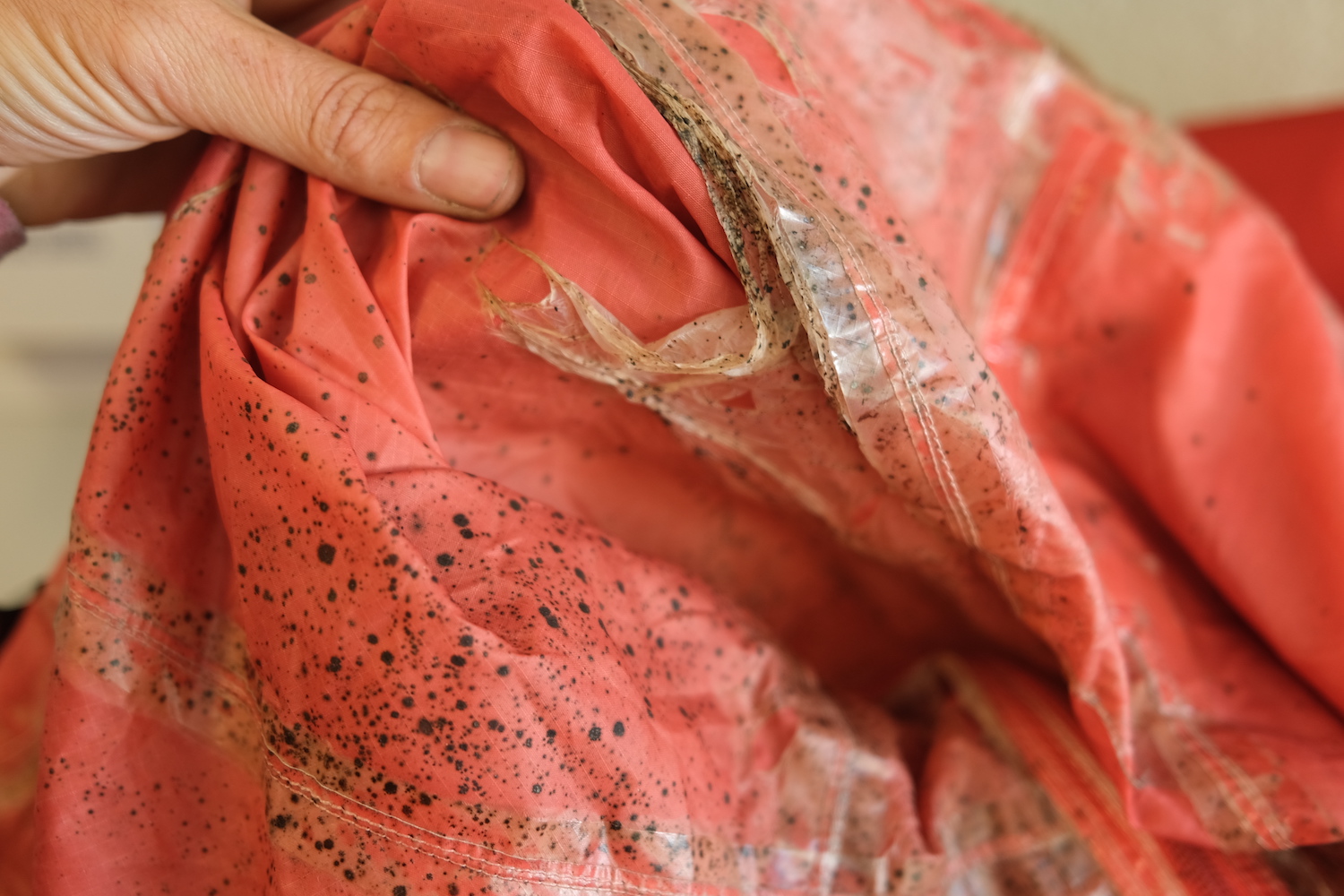
(My rain jacket on the Florida Trail: fascinating but not waterproof.)
Quality Baselayers
For this trip, my baselayers included VOORMI Baselayer Bottoms, a VOORMI Long Sleeve Baselayer Crew, and a Showers Pass Apex Tech T-shirt (more on that later.)
VOORMI is a US-based outdoor clothing company that specializes in durable, sustainably-produced natural wool textiles. Their baselayers combine fine-micron merino wool with a thin inner layer of moisture-wicking fibers.
I wore the baselayer crew while riding, camping, and sleeping. I found it to be reliably warm, comfortable, and well-made. It did a good job of wicking sweat from my body without feeling saturated. This will become one of my permanent backcountry gear items for a long time.
I wore the baselayer bottoms while at camp or sleeping. (Merino wool is a little more delicate than synthetic fibers, so I didn’t want to increase the risk of wear and tear by wearing the bottoms while I rode, when there would be significant friction from rubbing on the saddle.) This meant that I had to pack an extra pair of lycra riding leggings, which was a bit redundant. However, I got really attached to the VOORMI bottoms so I kept them anyway.
One of VOORMI’s unique strengths is that their clothing lines often come in beautiful, rich colors. This might seem irrelevant, but when you’re wearing the same thing for months at a time, good colors can make you happier. The VOORMI pants were a beautiful burgundy and the top was a multi-hued light blue.
Like the top, the VOORMI bottoms were reliably warm, comfortable, and well-made. The fabric was cut and stitched in a way that was both useful and lovely. In bright light they were slightly see-through, so I think most people wear them under another layer. It didn’t really bother me. In the future I’ll pack them in my backcountry hiking kit, which I think is a perfect usage.
One of the best parts of wearing merino wool on long trips is that it tends to resist body odors. The VOORMI baselayers stayed fresh-smelling the whole time, even though I wore them daily and rarely washed them. A miracle!
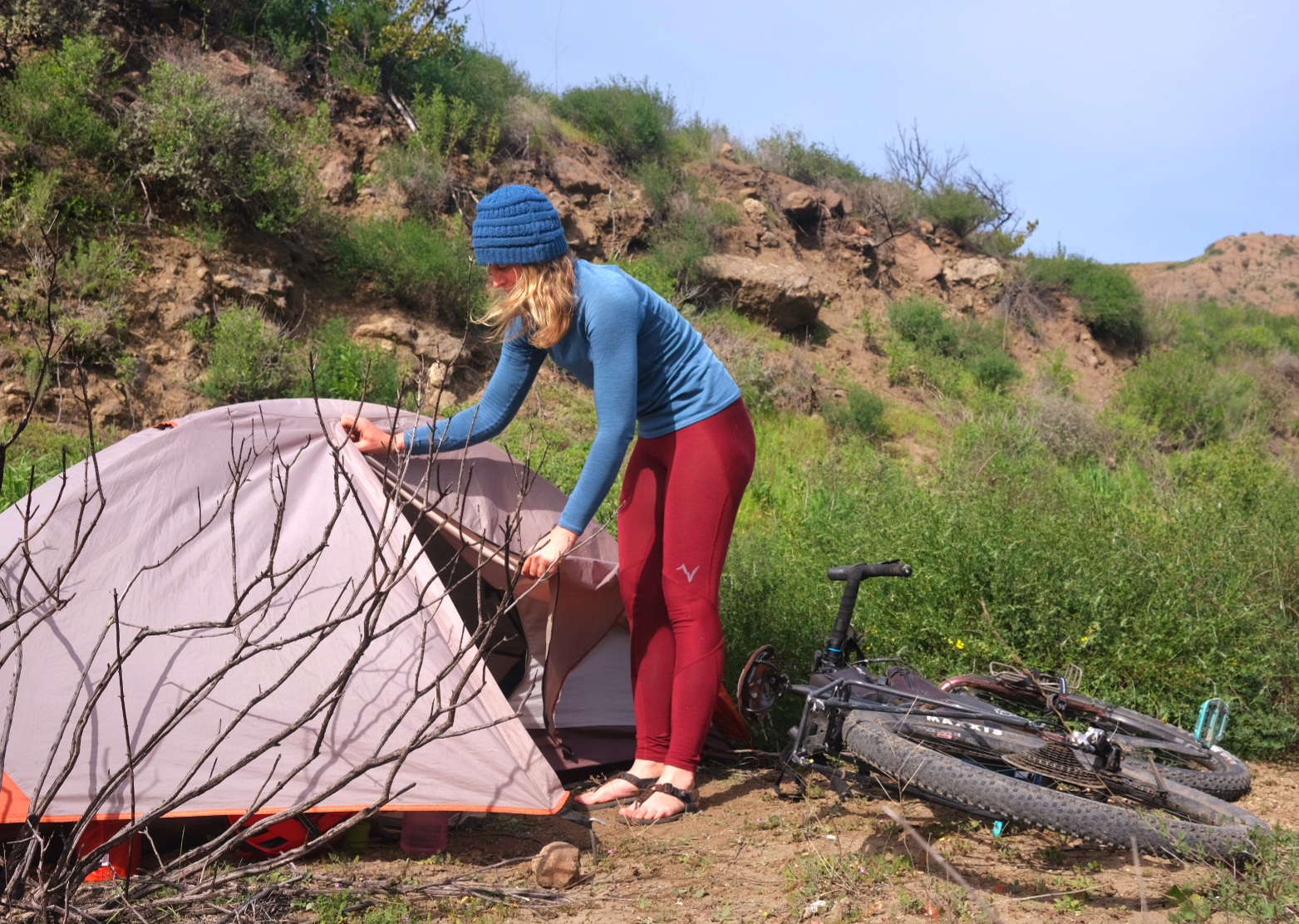
Quality Rain Gear
My rain gear works hard. It keeps me dry in wet or foggy weather, acts as a windbreaker on blustery days, and functions as an overlayer when it’s especially cold. When it’s cold and wet out in the backcountry, it literally saves my life.
On this trip I wore my raingear at least a quarter of the time, mostly as a windbreaker or overlayer. When temperatures hit record lows in February, I even wore my rainpants and rainjacket to bed over the rest of my clothes. Most people on long bikepacking or backpacking trips will need their raingear to be multifunctional in this way.
Along the Pacific Coast I wore Showers Pass Transit Pants and a Showers Pass Refuge Jacket. These fit over all my other layers, including my Showers Pass Apex Merino Tech T-shirt, which functioned as a stand-alone riding shirt or additional baselayer. These three items were fantastic.

Showers Pass is a Portland-based outdoor clothing company that specializes in waterproof, breathable rain gear for cyclists and multi-sport outdoor athletes and enthusiasts. A lot of their gear is designed for cool and cold weather commuters who also enjoy other outdoor pursuits like hiking, running, and climbing. Their lineup also includes a range of lightweight raingear designed specifically for mountain biking and bikepacking.
I loved having these pants with me on windy, cold, or wet days! And those were most of my days on the Pacific Coast!
I appreciate the Transit Pants’ sturdy construction, articulated knees, and zippered bottoms. They were easy to take on and off quickly when I needed to layer up or down. They also have a thick elastic waist which I found to be useful for tucking in my other layers. Many rain pants have a much smaller elastic waistband which often isn’t as effective.
I found these pants to be comfortable either on or off the bike. The sturdiness of the fabric also made them particularly useful in cool weather as an outer layer at campsites. They weren’t the lightest rain pants I’ve ever had, but they were still within a reasonable range and quite packable. (I generally prefer reliability over lightness anyway, especially on longer trips when gear needs to last to the end.) I’ll definitely pack the Transit Pants again on future trips, either biking or hiking.
Ahhhh, the Refuge Jacket! One day I wore this jacket into an REI, and the clerk at the register took one look at me and said, “WOW, that’s a GREAT jacket!” When the folks at REI are complimenting your outerwear, it’s a good sign.
The Refuge Jacket is a bomber jacket. I wore it in rain, snow, wind, and hail, and it delivered me to my destination warm and dry. Special features include great waterproof zippers and vents, appropriate pockets and hand warmers, a good sized removable hood, and reinforced shoulders. One of my favorite design choices was also the light fleece cloth on the neck. This made me feel super cozy even in cold weather, but was also easy to unzip and pull away from my face when it was warmer out.
Like a lot of the Showers Pass lineup, this jacket seems to be designed with cool or cold, wet, climates in mind. (The company is based out of the Pacific Northwest, so this tracks with their focus on that particular climate.)
The yellow version of this jacket (which the company refers to as “Goldenrod” but I like to think of as “California Poppy” since it perfectly matches the poppies here) was priceless on gray days with constant rain in the city. I felt SEEN. Showers Pass designs their products with commuters in mind, so both the jacket and pants came with subtle reflective strips which always made me feel more secure while biking in traffic.
Similar to the Transit Pants, the Refuge Jacket is not the lightest jacket out there– but that’s the tradeoff for being fully waterproof and including features like extra vents and truly waterproof zippers. It was still very packable and will definitely go into my gear bag for future hiking and biking trips in cool or cold climates.
Showers Pass Apex Merino Tech T-Shirt
The first time I put this shirt on, I giggled. It’s so silky! It made a fantastic baselayer while riding, camping, and sleeping. I found it to be warm, reliable, and extremely comfortable. Another keeper. If you’re looking for a silky smooth merino, this one does the trick.

Onward To The Desert!
After cycling the Pacific Coast to Ventura, I hooked a left and headed inland toward the desert. Now I’m on a mission to find the best remote offices in remote places to continue remote work. Each day, my bike commute takes me somewhere new. You can follow my journey on Instagram @laurakillingbeck
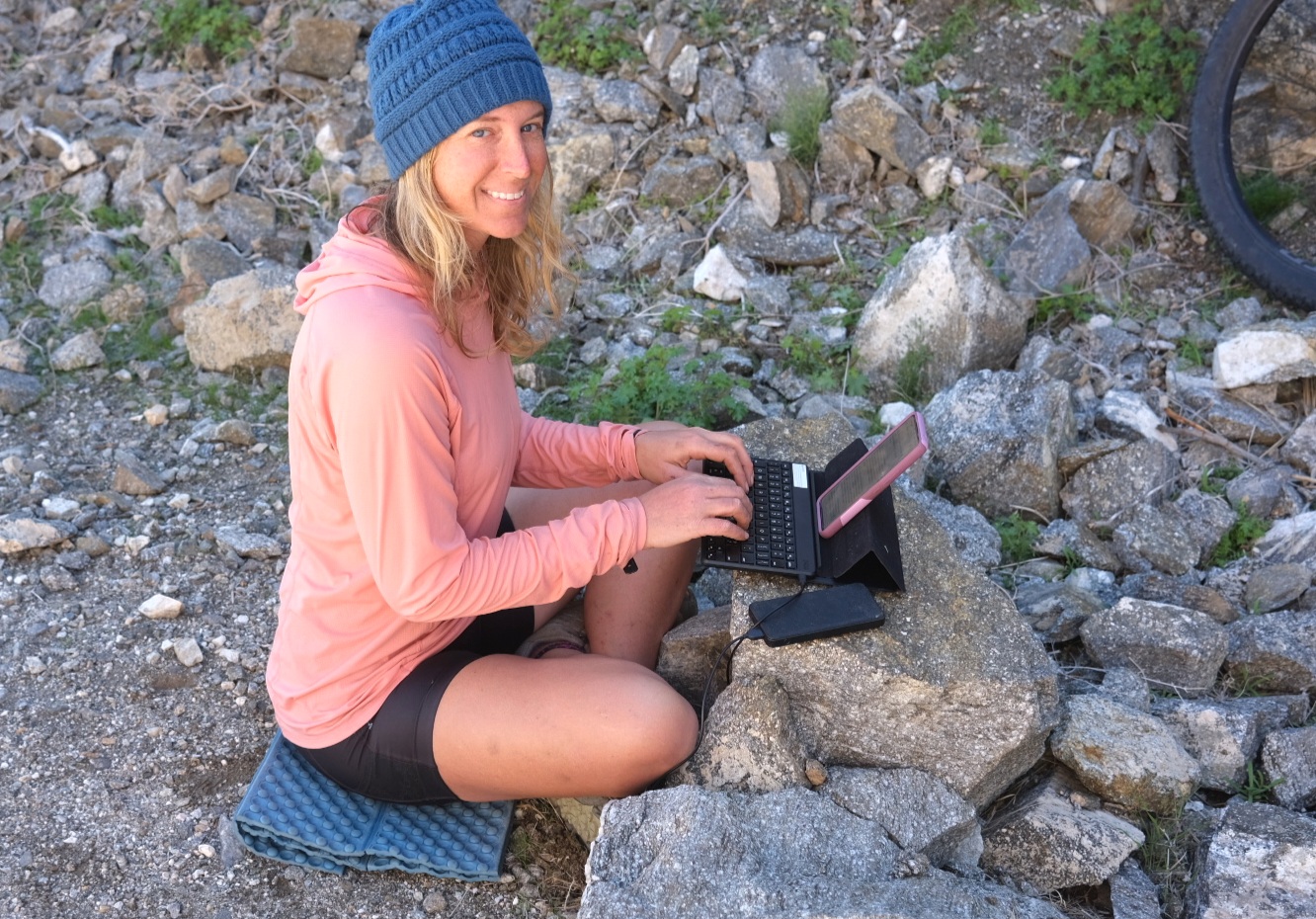
(This office rocks!)

